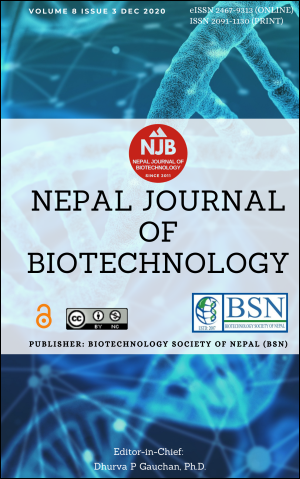Comparative Study of Bioactive Compounds in Different Varieties of Pears in Nepal
DOI:
https://doi.org/10.3126/njb.v8i3.33663Keywords:
Pears, Physicochemical parameters, Antioxidants, Phenolic content, Pharping localAbstract
This study was conducted to evaluate the physicochemical parameters, perform qualitative tests (for sugars and phytochemicals), and quantitative tests (phenolics, antioxidants, anthocyanins, tannins, vitamin C) of six different varieties of pears i.e. Bartlette, Chinese pears, Chojuro, Kosui, Pharping local, and Yakumo. The juices extracted from respective pears were used for the analysis. The phenols were determined by the Folin-Ciocalteu method, antioxidants by the DPPH scavenging activity, and anthocyanins by a SO2 bleaching technique. The Pharping local pears were found to have the highest anthocyanins (85.95±0.1 mg/l), total phenolic content (600±0.01 mg GAE/l), antioxidants (IC50 value 250±0.00 mg of phenol/l) and vitamin C content (12.2±0.01 mg/100 ml) and tannins were observed to be highest in Yakumo pears (0.93±0.01 g/l). Likewise, the highest clarity i.e. 1.960±0.00 was observed in Bartlette pears and the highest acidity (2.01±0.01%) in Chojuro pears. Various sugar/carbohydrate tests like Molisch’s test, Benedict’s test, Barfoed test, Bial’s test, Seliwanoff test, Fehling’s test and Iodine test were performed for the pear varieties. All the pears gave positive results for all the sugar tests except Iodine test. The positive results for sugar/carbohydrate signifies the presence of various sugars that help for the better taste, texture, and aroma of pear. The pear varieties showed the presence of phytochemicals like flavonoids, terpenoids, catechins, cyclic glycosides, and proteins. The phytochemicals are responsible for fruit preservation and act as anti-carcinogenic components. Among the varieties of pears, Pharping local pears were observed to be most nutritional because of high antioxidants, phenols, anthocyanins, and vitamin C.
Downloads
Downloads
Published
How to Cite
Issue
Section
License
Copyright Notice:
The manuscript submitted to NJB must be an original contribution, not previously published and should not be under consideration for publication elsewhere. When the manuscript is accepted for publication, the authors agree to automatically transfer the copyright of the article to the publisher. It should grant permission to any third party, in advance and in perpetuity, the right to use, reproduce or disseminate your article, according to the NJB copyright and license agreement.
Authors transfer copyright to the publisher as part of a journal publishing agreement but have the rights to: Share their article for Personal Use, Internal Institutional Use and Scholarly Sharing purposes, with the NJB applies the Creative Commons Attribution-NonCommercial CC BY-NC license to all the works we publish after Jun 2020 (Before it was CC BY-NC-ND). Under this license, authors agree to make articles legally available for reuse, without permission or fees, for virtually any non-commercial purpose. Anyone may remix, adapt, and build upon your work non-commercially, and although their new works must also acknowledge you and be non-commercial, they don’t have to license their derivative works on the same terms. More details on CC BY-NC refer to its Licence Deed and Legal Code.






